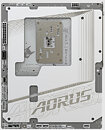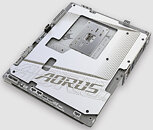TheLostSwede
News Editor
- Joined
- Nov 11, 2004
- Messages
- 18,348 (2.46/day)
- Location
- Sweden
| System Name | Overlord Mk MLI |
|---|---|
| Processor | AMD Ryzen 7 7800X3D |
| Motherboard | Gigabyte X670E Aorus Master |
| Cooling | Noctua NH-D15 SE with offsets |
| Memory | 32GB Team T-Create Expert DDR5 6000 MHz @ CL30-34-34-68 |
| Video Card(s) | Gainward GeForce RTX 4080 Phantom GS |
| Storage | 1TB Solidigm P44 Pro, 2 TB Corsair MP600 Pro, 2TB Kingston KC3000 |
| Display(s) | Acer XV272K LVbmiipruzx 4K@160Hz |
| Case | Fractal Design Torrent Compact |
| Audio Device(s) | Corsair Virtuoso SE |
| Power Supply | be quiet! Pure Power 12 M 850 W |
| Mouse | Logitech G502 Lightspeed |
| Keyboard | Corsair K70 Max |
| Software | Windows 10 Pro |
| Benchmark Scores | https://valid.x86.fr/yfsd9w |
Gigabyte's new Stealth series of motherboards has to date only had a single product, the Z690 Aorus Elite Stealth, but now, Gigabyte has added its first Stealth board for AMD CPUs. The B650E Aorus Stealth Ice not only has all of its connectors on the back of the board, but it also has a white/silver PCB with a similarly coloured front and back cover. Apart from the DIMM slots, all connectors are also in somewhat matching colours, although judging by the pictures, the colours don't quite match on all the connectors and slots. That aside, the B650E Aorus Stealth Ice is a pretty competent board, as long as you're not interested in adding anything more than a graphics card and some NVMe SSDs, as it has zero additional PCIe expansion slots. It's a rather bold move by Gigabyte, but at the same time, most gamers and consumers don't tend to add PCIe devices to their computers outside of additional storage these days.
Besides the PCIe 5.0 x16 slot, you get two M.2 sockets wired to the CPU, one PCIe 5.0—with its own, larger heatsink—and one PCIe 4.0, as well as a third PCIe 4.0 M.2 socket via the chipset. There's also support for four SATA 6 Gbps drives if more storage is needed. Gigabyte has also added an internal HDMI 1.4 port that's limited to 1080p30, which is intended to be used with Gigabyte's LCD Edge View display. Other connectivity on the back of the PCB includes a USB 3.2 Gen 2x2 (20 Gbps) port, a USB 3.2 (5 Gbps) pin-header as well as the usual USB 2.0, fan headers and LED headers that you'd expect from a modern motherboard. The VRM design is a 12+2+2 design with a 60 Amp DrMOS configuration for the 12+2 phases for the CPU and GPU.





Around the rear of the board you'll find a single HDMI 2.1 port which is limited to 4K 60 Hz, a USB Type-C port that delivers 10 Gbps of data in most instances—but will support USB4 with the right APU in the CPU socket—that also offers PD Alt Mode support for up to 4K 144 Hz. There's also a 2.5 Gbps Ethernet port, Gigabyte's newWiFi EZ-Plug for the WiFi antenna, which is connected to a MediaTek MT7925 WiFi 7 / Bluetooth 5.4 module, which sadly is limited to 160 MHz channel width. Finally there are two 10 Gbps USB Type-A ports, five 5 Gbps USB-Type A ports and four USB 2.0 ports, three audio jacks connected to the old ALC897 audio chip and a Q-Flash Plus button. Overall it looks like a pretty competent B650E board, but with the 800-series chipset just around the corner, it might have been wiser to release this as a B850 board, at least to win over consumers that don't know that the two are the same chipset. Gigabyte provides a list of compatible chassis here.
View at TechPowerUp Main Site | Source
Besides the PCIe 5.0 x16 slot, you get two M.2 sockets wired to the CPU, one PCIe 5.0—with its own, larger heatsink—and one PCIe 4.0, as well as a third PCIe 4.0 M.2 socket via the chipset. There's also support for four SATA 6 Gbps drives if more storage is needed. Gigabyte has also added an internal HDMI 1.4 port that's limited to 1080p30, which is intended to be used with Gigabyte's LCD Edge View display. Other connectivity on the back of the PCB includes a USB 3.2 Gen 2x2 (20 Gbps) port, a USB 3.2 (5 Gbps) pin-header as well as the usual USB 2.0, fan headers and LED headers that you'd expect from a modern motherboard. The VRM design is a 12+2+2 design with a 60 Amp DrMOS configuration for the 12+2 phases for the CPU and GPU.





Around the rear of the board you'll find a single HDMI 2.1 port which is limited to 4K 60 Hz, a USB Type-C port that delivers 10 Gbps of data in most instances—but will support USB4 with the right APU in the CPU socket—that also offers PD Alt Mode support for up to 4K 144 Hz. There's also a 2.5 Gbps Ethernet port, Gigabyte's newWiFi EZ-Plug for the WiFi antenna, which is connected to a MediaTek MT7925 WiFi 7 / Bluetooth 5.4 module, which sadly is limited to 160 MHz channel width. Finally there are two 10 Gbps USB Type-A ports, five 5 Gbps USB-Type A ports and four USB 2.0 ports, three audio jacks connected to the old ALC897 audio chip and a Q-Flash Plus button. Overall it looks like a pretty competent B650E board, but with the 800-series chipset just around the corner, it might have been wiser to release this as a B850 board, at least to win over consumers that don't know that the two are the same chipset. Gigabyte provides a list of compatible chassis here.
View at TechPowerUp Main Site | Source











